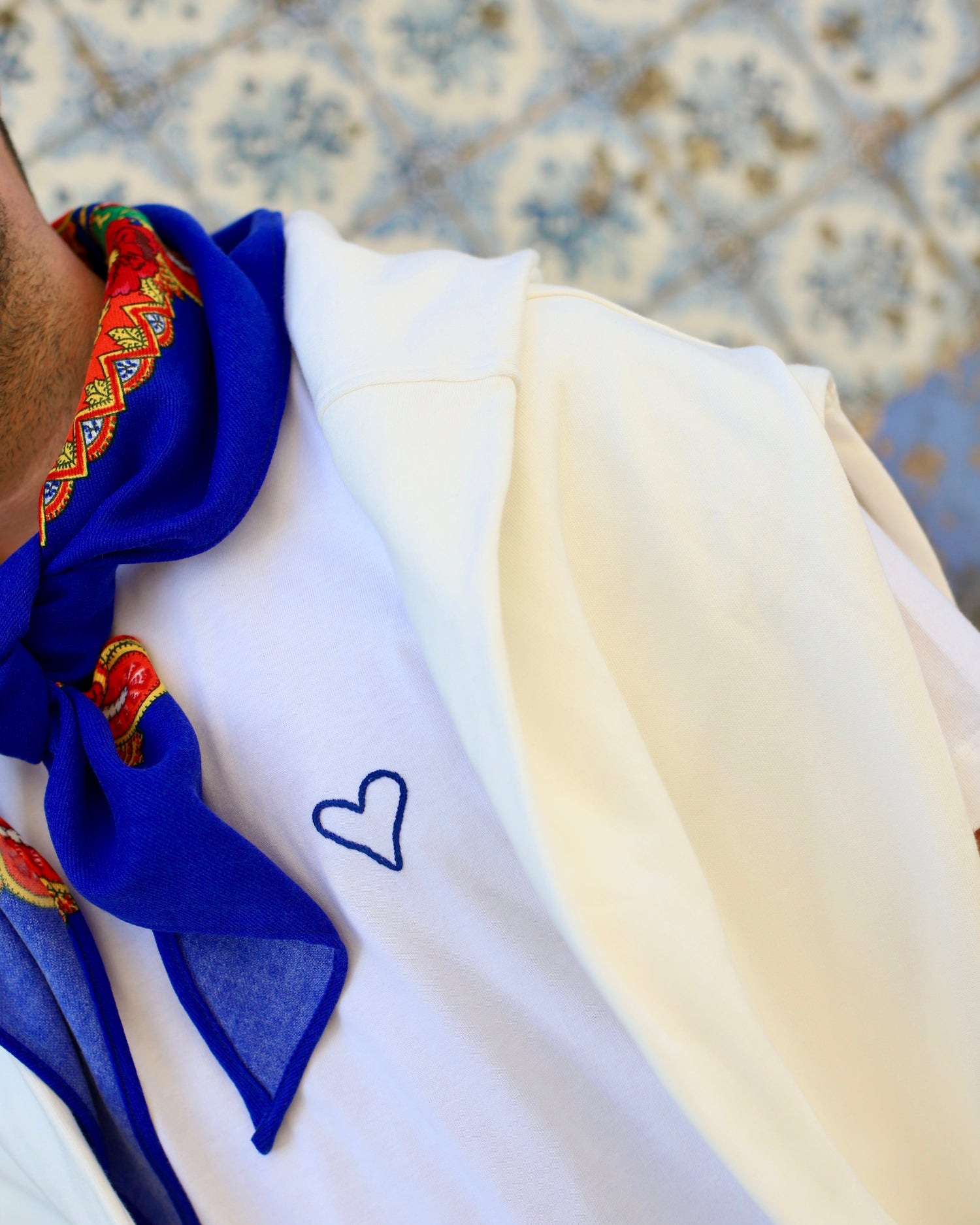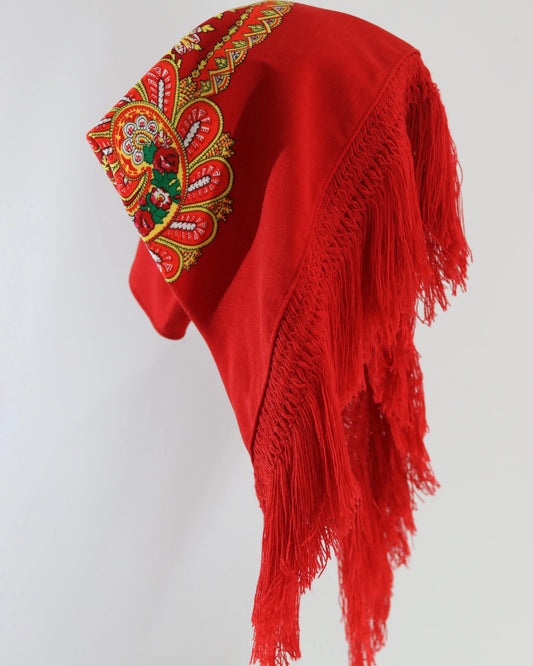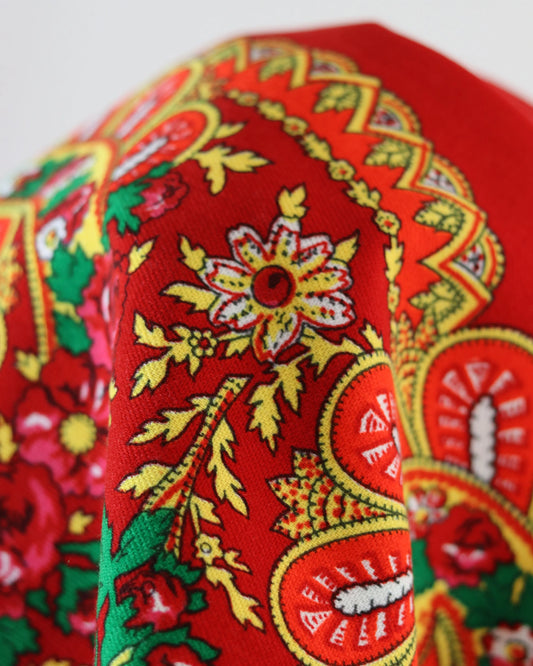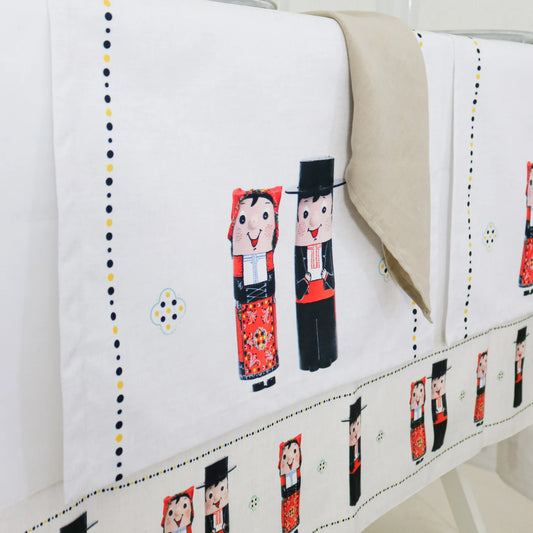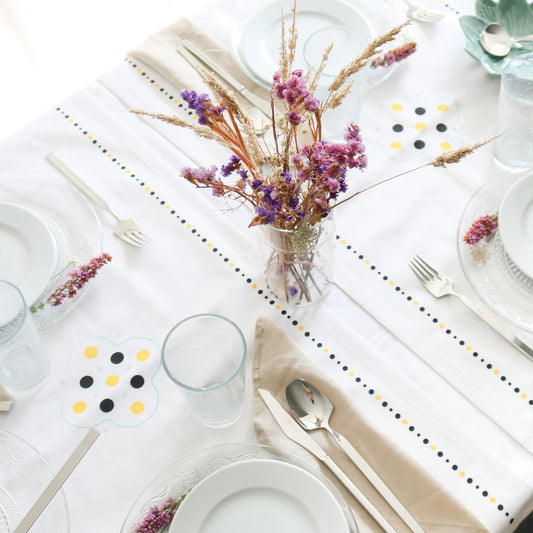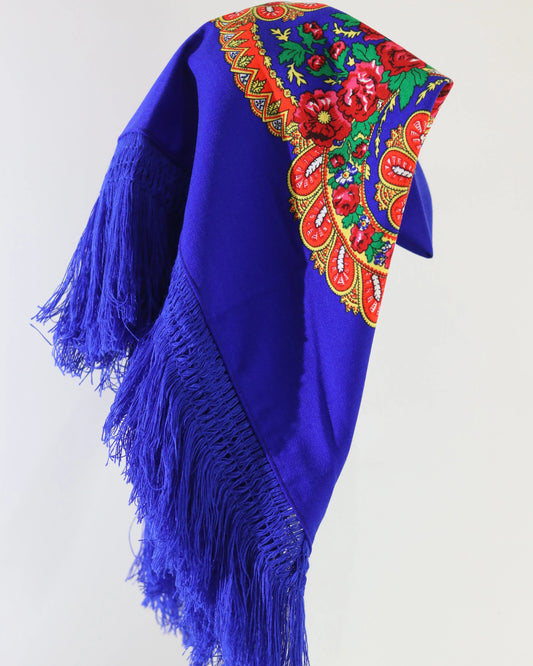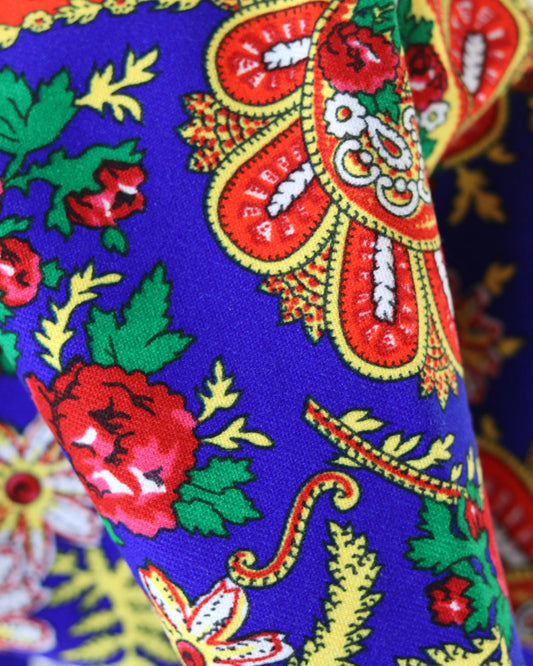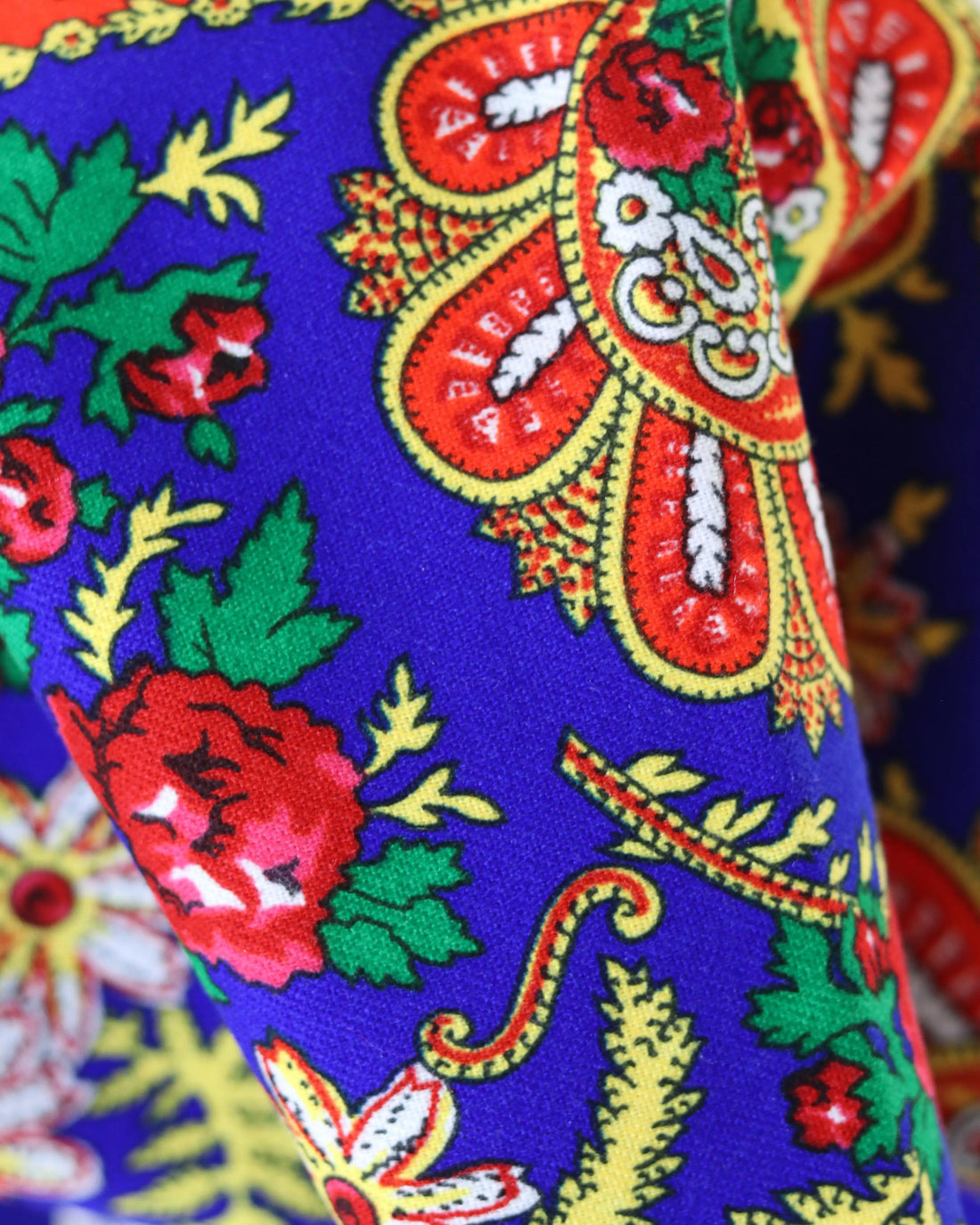
Buy the Lenço de Viana – History, Types and Tradition of a Portuguese Symbol
The embroidered heart of Viana do Castelo
Buying a Viana scarf is much more than a gesture of consumption. It's an act of love and belonging, a tribute to a history woven into every thread. The scarf is one of the great emblems of Viana do Castelo and Minho, a piece that, over the centuries, has earned a place in the country's memory. Those who wear it carry not just a colorful cloth; they carry the soul of a city that learned to express its heart with lines and colors.
During the pilgrimages to Senhora d'Agonia, the scarf appears as a sea of color and movement. To the sound of drums and accordions, the streets transform into a stage of faith and celebration. In traditional attire, the scarf complements the glitter of gold, apron, and shawl, in an ensemble that speaks of identity. But its meaning goes beyond appearance. For generations, it has been an embroidered love letter, a silent promise, a farewell memento, and a sign of reunion. Each stitch has intention, and each color a meaning that the people learn early and cherish forever.
From the origins to the present
The scarf's roots lie in the centuries of devotion and celebration that shaped the Minho region. Long before becoming a tourist symbol, the scarf was an everyday item. It protected from the sun, wind, and rain, but also marked holy days and market days. With the widespread adoption of lightweight fabrics like cotton and later viscose, the scarf gained reach and variety. What was once a luxury for a few became part of the trousseau of many. In Viana, the hands that embroidered introduced hearts, flowers, and words that speak of love and faith. The Minho heart, made with a long curve and a secure tip, appears alongside the stylized flower and the ear of corn that promises abundance. The composition varies, but the message remains. Giving a scarf is saying without words what you want the other to hear forever.
In the twentieth century, the scarf's presence at festivities gave it fame beyond the Minho region. Among stewardesses and farmworkers, between processions and processions, photography established an icon. At the same time, emigration carried the scarf in its purse and in its memory. In homes in Paris, Zurich, or Toronto, a scarf hanging in a frame keeps the land close. This intimate gesture explains why buying a scarf today remains an act of belonging. It's bringing home a fragment of celebration and longing.
The three types of Viana scarf
Despite sharing the same soul, we usually speak of three types that best identify the local tradition: Minhoto, Meadela, and Vianense. The distinction is based on usage, design, and the presence of fringes or more restrained motifs. Understanding these differences helps you choose wisely and respect the language the city has established.
Minhoto Scarf
The Minhoto scarf is, for many, the most recognizable face of the tradition. Square, solid, and lightweight, with a fringe that gives it sway, it creates intense floral patterns where color is king. Red stands out in joyful celebrations, blue brings serenity, and white emphasizes the purity of lines and the contrast of the design. It's a sure presence in dances and parades, as it pairs well with the shine of gold and the profusion of the costume. Those seeking the canonical style will find good references in d'Agonia's selection. You can see, for example, the Minhoto-style Viana scarf with white fringe , the Minhoto-style Viana scarf with blue fringe , and the red Minhoto-style Viana scarf . Each color evokes an emotion and a moment, faithfully maintaining the grammar of the design that the city recognizes.
Meadela scarf
The Meadela scarf is named after the parish that gave it a reputation for elegance. It's chosen by those who prefer restrained harmony. The compositions tend to emphasize balance, with less strident colors and carefully arranged motifs. The Meadela farmers were known for their attention to detail and a natural solemnity on church days. This scarf embodies that spirit. It doesn't impose itself with exuberance, but rather convinces with its discretion. Those who wear it appreciate the serenity and clarity of the design, without losing touch with tradition. In today's context, it works well for both celebrations and urban wear, adding a touch of Viana to a contemporary wardrobe.
Vianense Scarf
The Vianense scarf is the soul of the people made into fabric. It lives on in the wrists of those who dance and in the joyful cries of those who arrive in Ribeira in August. The compositions accept great variation, the color spreads freely, the flowers multiply as if the countryside had ascended to the city. It is the scarf that travels the most and appears most in photographs around the world. It carries Viana on the chest of those who have departed and reminds the visitor that here, color is not adornment, but language. All these differences help in choosing, but none of them closes the path. The meaning lies in use and respect. Any of these three types, when authentic, fulfills the same mission: to be a sign of belonging and beauty.
How to recognize an authentic scarf
Authenticity is a word that is felt in the hands and in the eyes. The Viana scarf features a design consistent with local tradition. The Minho heart appears with tense lines, the flowers occupy the space with rhythm, and the leaves complete the composition. The color has body and won't fade after the first wash. The fringe, when present, isn't randomly glued on; it follows the fabric naturally and enhances the movement. The label indicates the origin and material. In current models, viscose is often used for comfort and drape, but there are historical records with cotton and blends. More than technology, what matters is respect for visual language and cultural function. This is what separates the memento from imitations without context.
For those looking to shop with confidence, the dedicated collection brings together the best of living tradition. Explore the selection at Lenços de Viana . There, you'll find a variety of colors and compositions, curated with rigor and loyalty to local culture.
Traditional uses and contemporary uses
The scarf arises from simple needs and symbolic functions. It covers the head on sunny days, warms the neck when the Lima wind blows, identifies the parish in procession, and connects the pilgrimage to home. Folded in a triangle, it rests on the shoulders with the ends crossed in front and pinned to the chest. Worn on the head, it protects and beautifies. In a modern context, its versatility surprises. It functions as a scarf, a hair ornament, an improvised belt, a bag ribbon, a tablecloth in corners of the room begging for a souvenir. In urban fashion, it brightens up knitwear, blazers, and dresses. The key is balance. The scarf demands prominence, but it also restores harmony when worn with plain pieces. Regardless of its use, it's worth remembering that we're talking about a cultural object. The way we wear it should honor its origins, even when the language changes.
Colors and meanings
The color code isn't written law, but tradition has left its mark. Red speaks of love and courage. Blue summons serenity and faith. White suggests purity and clarity. Green evokes hope and the promise of the countryside. Black represents devotion and respect. Gold appears in contours and details, echoing the shine of gold that established itself in Viana. These senses help in choosing, especially when the scarf is a gift. A birthday calls for bright red, a family celebration accepts white with notes, a personal promise finds a faithful companion in blue. The beauty of the scarf also lies in this possibility of expressing with color what is sometimes missing in speech.
Buying Viana's scarf with confidence
Buying the right scarf means supporting intangible heritage and continuing a language passed down from mother to daughter. At d'Agonia, curation prioritizes quality, authenticity, and respect for local grammar. For an informed choice, start with the core collection of Viana Scarves . If you're looking for a more classic style with fringes and a solid color that makes a big impact, consider three styles that epitomize the Minhoto spirit. The full-length Minhoto with white fringe offers luminosity and contrasts with gold and the denser patterns of the costume. The full-length Minhoto with blue fringe brings serenity and presence, much appreciated in festive settings. The red Minhoto is the statement of those who celebrate without reservation. In any case, conscious purchasing begins with understanding what you're looking for. A scarf to keep as a heirloom, a scarf for dancing, a scarf for everyday use. Function guides the choice and protects the investment.
Care and conservation
A well-cared-for Viana scarf lasts decades and can be passed down from generation to generation. Wash with cold water and mild detergent. Avoid twisting, which damages the fibers. Air drying preserves shape and color. Iron inside out at a moderate temperature, using a thin cloth to protect the surface. When the scarf has fringes, it's best to carefully detangle them, using your fingers or a wide-toothed comb. Storage requires a dry place away from direct light. Some families keep their scarves in boxes lined with acid-free paper. This care isn't a matter of preciousness; it's a recognition of cultural value. A scarf is an object of memory. It deserves archival care without succumbing to the rigidity of a museum. A scarf's place is life.
The scarf as a gift
Some gifts are simply useful. There are gifts simply beautiful. The Viana scarf combines both and adds a story. Giving a scarf is offering belonging. It's telling the recipient that we share their trust in an ancient gesture that has endured wars, departures, and returns. For those who live abroad, a scarf that arrives in the mail transforms a room into a home and a home into Viana for a moment. For those who live nearby, a scarf brings back the first visit to Senhora d'Agonia, hand in hand with their grandmother. A fabric awakens layers of memory. So, when thinking about a gift, choose the scarf with intention. You consider the color that best reflects the occasion, the texture that best suits the wearer's style, the design that best speaks to our shared history. The rest comes by itself.
A historian's journey between the sacred and the popular
Over decades of studying Minho rituals, I've learned that a handkerchief is a bridge. It connects the church to the street, the silence of the promise to the din of the raid, the solemnity of the altar to the laughter of the festival. I saw handkerchiefs wafting from the window as the band passed by, I saw handkerchiefs hanging on the wall of emigrants who return in August just to hear the sounds of the festivities. I also saw, in family trunks, old handkerchiefs folded with an almost liturgical respect. When a granddaughter opens the trunk, her grandmother tells the story of the day she received that handkerchief. This is how tradition is passed on. Not by decree, but by narrative and gesture. Buying a handkerchief today is to insert yourself into this chain. It's to continue a sentence that others began and that others will finish.
Living tradition and future
Culture doesn't survive through mechanical repetition. It survives when a new hand learns the ancient language and speaks it truthfully. The scarf has changed over time, but it hasn't lost its center. It has seen new materials and uses emerge, but it has maintained its heart and flower design. It has seen its momentum grow with the visibility of the Festas d'Agonia and the appreciation of Portuguese crafts. It has even seen e-commerce open doors to those who live far away. When purchases are made with discretion, this openness doesn't dilute authenticity. Rather, it enhances it. A scarf that leaves Viana for the world carries with it the commitment of its owner.
Where to buy the Viana scarf
For a safe and informed purchase, check out the dedicated collection at Lenços de Viana . The curated selection ensures fidelity to tradition and quality of execution. If you're looking for the iconic model with fringe and a solid color that delivers a striking expression, check out the references already listed. The full Minhoto with white fringe is a luminous choice, the full Minhoto with blue fringe offers a serene presence, and the red Minhoto affirms joy. With any option, you buy more than one accessory. You buy a symbol.
Conclusion
Buying a Viana scarf is touching the essence of a city that learned to transform fabric into language. It's recognizing the value of hands that embroider, women who dance, families who treasure memories in linen-scented chests. It's taking home a poem without letters, just color and stitch. When choosing, remember what the scarf asks of the buyer: respect, awareness, and joy. The rest is just the party.
Frequently asked questions
What is the practical difference between Minhoto, Meadela and Vianense?
The Minhoto is the most emblematic, square, light, with fringes and intense color, designed for a strong visual presence. The Meadela favors balance and discretion, with more restrained motifs and calm tones. The Vianense adopts a popular spirit and generous colors, often associated with rucks and street parties. All are authentic when they respect the design and execution linked to local tradition.
How to choose the right color
Some cultural significance helps. Red represents celebration and affirmation, blue represents serenity and faith, white represents purity and light, green represents hope, and black represents devotion. When giving gifts, consider the recipient's personality and the context of use. When in doubt, white and blue are versatile choices that work in many settings.
What is the ideal size?
Traditional square scarves offer greater versatility, both for shoulders and head. For those looking for visual impact in an outfit or photograph, models with fringes and a good drape are a safe option. In an urban setting, a medium-sized square allows for multiple ties without compromising comfort.
How to confirm authenticity
Observe the coherence of the design, color quality, balance of motifs, and finish of the fringes. Look for proof of origin and trustworthy curation. At d'Agonia, the selection of Viana scarves follows criteria of fidelity to tradition and quality of materials.
How to care for and store
Hand wash with cold water and mild detergent, air dry, iron inside out with a protective cloth, and store folded in a dry place. If you have bangs, detangle them slowly. This care preserves color, texture, and durability.
Can I use the scarf in everyday life?
Yes. Tradition lives on in use. Worn around the neck, on the head, as a headband, or as a bag adornment, the scarf adds color and history to contemporary looks. The important thing is to wear it with respect for its origin and the symbolism it carries.



